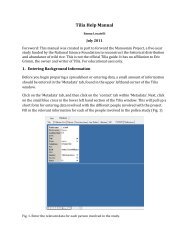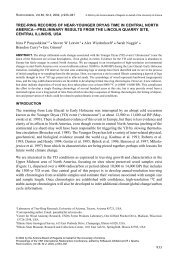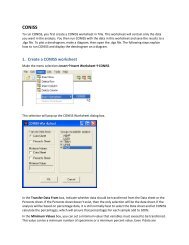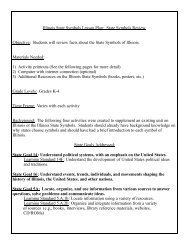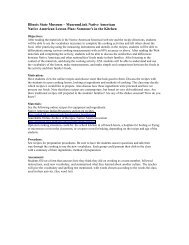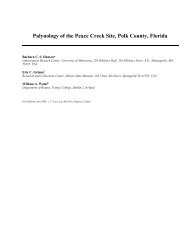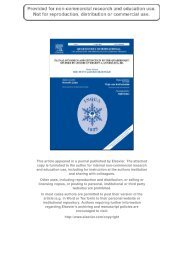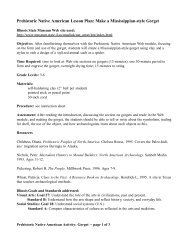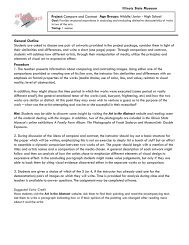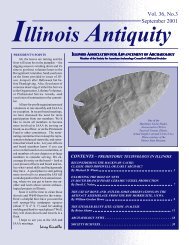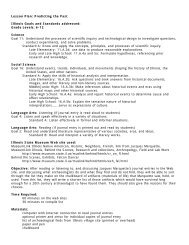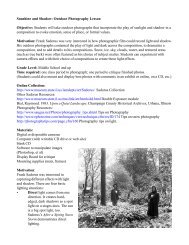Model Wigwam Lesson Plan: Grade Levels - Illinois State Museum
Model Wigwam Lesson Plan: Grade Levels - Illinois State Museum
Model Wigwam Lesson Plan: Grade Levels - Illinois State Museum
- No tags were found...
Create successful ePaper yourself
Turn your PDF publications into a flip-book with our unique Google optimized e-Paper software.
<strong>Model</strong> <strong>Wigwam</strong> <strong>Lesson</strong> <strong>Plan</strong>:<strong>Grade</strong> <strong>Levels</strong>: 5-8Objective: After reading the materials in the web site on <strong>Illinois</strong> Indian homes, and completingthis activity, the students will be able to explain what a wigwam is and of what materials andmethods one was built.Time Required: Allow several hours (perhaps a combination of social science classes and anart period, working with the art teacher)for each PAIR of students (it takes more than twohands to tie the reeds together.Materials:For each wigwam: soft, pliable sticks such as willow branches or #6 round basket reeding (twolong strands; one package will make about 10 wigwams, or do basketry, too)). It is best tomeasure as you build rather than precut all.7 about 15" long2 about 17" long1 about 24" long1 rectangular sheet of 1/2 “x 12” x 36" styrofoam for a base (or 1/2" thick corrugatedcardboard)50 lengths of string about 6" longpencilmarkercrumpled brown paper bags (with crayon texture drawn on to look like a woven mat) ORbrown felt (9" x 12"). These are cut into 4" by 4" rectangles scissors 12" x 18" piece ofgrass paper (model train supply) or green paper lichens, wadded paper, string, threadends, or other to make shrubsProcedure: (see instruction sheet with illustrations)Read (or have students read) and discuss the winter and summer villages and wigwam of theWeb site with the students. Give students the instruction sheet with illustrations and go throughit orally, answering student questions. Demonstrate major steps such as anchoring the sticksinto the base, and weaving the paper strips into mats. Emphasize that after the basic building isconstructed, the students may add to the model with landscaping, people, and material lifeobjects, USING THE INFORMATION FROM THE NATIVE AMERICAN WEB SITE TEXT ON THESETOPICS and the concept of scale. The instructions have the scale of 1 inch = 23 inches, so themodel wigwam will be 12" long, 8" wide, and about 5" tall. Any figures, trees, etc. Shouldreflect that scale.Assessment: Students may present their model orally to the class, explaining the structure,building, use, origin, etc. of the wigwam and project. Criteria will be proportional scale, historyof the shelter, and fluency in answering questions about the form, materials, and use ofwigwams.<strong>Illinois</strong> Goals and Standards addressed:Social ScienceAll <strong>Levels</strong>: Goal 18: Understand social systems, with an emphasis on the United <strong>State</strong>s.Standard A: Compare Characteristics of culture as reflected in language, literature, thearts, traditions, and institutions.Mathematics: Estimation and MeasurementGoal 7: Estimate, make and use measurements of objects, quantities, and relationships anddetermine acceptable levels of accuracy.Standard A: Measure...using appropriate units, instruments, and methods.Middle/Junior High: 7.A.3b: Apply the concepts and attributes of length, ...perimeter,...and angle measures in practical situations.Early High: 7.A.4a: apply units and scales to describe and compare numerical data andphysical objects. (Works with grades as low as 5th with help from teacher.)
Instruction Sheet for <strong>Model</strong> <strong>Wigwam</strong>Step One: Gathering the MaterialsYou will need:12" by 18" sheet of 1/2" thick styrofoam or cardboardpair of scissors capable of cutting cardboard and reedingpencilmarker9" by 12" sheet of drawing paper (not easily torn)12" rulercompass or an 8" length of string to tie around your pencilsmall bottle of wood gluedamp rag or paper towel2 full length pieces of #6 round basket reeding (each length is over ten feet long) or lots of willowtwigsmore than 12 inches longsink or tub of water for soaking reeds (enough water to cover reeds)tissue or length of toilet tissue to tear to use as post anchors12" by 18" piece of green paper or grass paperlichens or wadded material to use for shrubsStep Two: Making the BaseMaterials:a 12" by 18" sheet of 1/2" thick styrofoam or cardboarda pair of scissors capable of cutting cardboard and reedinga pencila markera 9" by 12" sheet of drawing paper (not easily torn)a 12" ruler1. Measure and draw a line twoinches in along one long side of the 9x12-inchpaper.Cut off the 1" section.2. Find the center point of the remaining section byfolding the paper in half lengthwise andwidth-wise. Open it up again. The center point isthe spot where the lines cross.
3. Measure 4" from each end of the paper and draw a dot onthe center line at the 4-inch marks.4. Adjust the compass for a 4" radius. Place thepoint of the compass on each dot in turn (and the pencil point atan edge of the paper, and draw a half-circle at each end ofthe paper. (If using a string, hold the pencil point at one end ofthe paper on the center line, hold the string down on the 4"point a finger, and draw a half-circle).5. Cut out the oval with scissors. This is the floor plan of yourwigwam. You will use it twice; once to transfer to your styrofoam,and later to transfer to your grass paper.6. Place the oval in the center of your 12" by18" styrofoam base. Trace around the edgewith a heavy marker, preferably brown orgreen. Also punch your pencil through thepoint where the center lines cross and make amark there. Remove the oval pattern and setaside for later.
Step Three: Building your <strong>Wigwam</strong>Marking your wall posts.1. Put your two lengths of reeding to soak and soften in a tub or sink of water (enough to cover thereeds). It will need at least 15 minutes to soak. If, during construction, the reeds get dry, resoak them.2. You will measure and draw dots for each of the 14 posts that will form the walls and ceiling of yourwigwam. Use the center dot you marked on the styrofoam to line up your dots. If you need to draw centerlines each way, do so.Mark the doorway posts at each end bymeasuring and making a dot 3/4 of an inchfrom each side of the center line (the doorwayswill be 1 1/2 inch wide).On each long side of the wigwam floor,measure and mark a dot for the side centerpost
One each side, between each center post andeach end post, measure and mark two moreposts (total eight) at two-inch intervals.You now have all your posts marked.NOTE: Gluing the reeds into the base: It is important that each end of the reed stays in thebase. To ensure this, poke each reed end into the base, remove it, put a drop or two of woodglue into the hole, pinch a little wad of toilet tissue, put a drop of glue on it, put a third dropof glue on the end of the reed. Then stuff the toilet tissue wad into the hole with the end ofthe reed. Pat down the extra tissue around the post to cement it in.Cutting and installing the reed postsDoorposts: Take one of the reeds out of the water and wipe the drips off with a towel. Measure 17" andcut with large scissors. Measure a second 17" length. Put the rest of the reed back into the water.These two reeds will reach from one doorway to another, the full length of the wigwam. Install each reedend as noted in the gluing directions. Both of theses reeds should be about the same height at thecurved top.Insert one end of one 17" reed into a dot at one end of thewigwam. Secure it. Bend the reed and insert the opposite endinto the post dot at the other end. Repeat for second doorpost.Three side center posts: The posts that go across from side toside will be placed over the lengthwise posts. The center postwill be the longest of the three. Cut 2 lengths of reed 15" long,and one 15 1/2" long. (You may need to adjust them to fitby cutting). Install the center post first. Then install the poststo either side, adjusting the length so that the curved top ofthe crosswise posts rest directly on the lengthwise posts.
After the glue is dry, use the 6" long yarn pieces to tie around the intersections of the posts you installedso far. Wrap the yarn around the intersecting reed in both directions and tie a double knot. Two outerside posts: Measure and cut two reeds that are 14" long. Install them in the post marks next to thedoor posts. Adjust the sizes before gluing so that the curved top rests on the lengthwise reeds. After theglue dries, tie the reeds together at the intersections.Two horizontal braces: The final three reeds will be placed around the wigwam. Measure and cut twolengths of reed 15" long (you will cut these to fit). Each one will stretch from one door frame, around aside of the wigwam, and attach to the other door frame. Try it first, cut to length so it does not block thedoorway, then hold and tie it (at least four hands needed here) to each reed it intersects. Adjust so thatthe reed is level all the way around the side.The last reed will circle the wigwam about halfway up. You needto add three extra inches for an overlap. Measure and cut a 30"length of reed. Arrange it around the middle of the wigwam so itrests on the other posts. Overlap the ends by three inches.Starting atthe center (opposite the overlapped ends), tie each intersectionwith yarn. Adjust the height so it is level. Tie the overlappedends together in several places.Congratulations! You have finished the structure of your wigwam. Next you will cover it with a roof madeof birchbark squares, woven cattails, or deer hides. Yours will be made of brown felt or crumpled paperbags.Covering the Roof:With 9 by 12 inch felt squares: cut each of three felt pieces into 4-inch squares:Start at the bottom of each side of your wigwam. Apply spots ofwood glue to the tied intersections, and dots on the reeds. Pressthe square onto the frame (you will need to hold, pinch, orweight them down until semi-dry). Overlap each piece of roofingto keep out the rain. Do not cover the doorways.
When the lower layer is dry, add the upper layer of felt squaresin the same manner with glue. Overlap them over the lower rowby about one inch, and over each other. Leave a hole in the topfor smoke to exit. Weight down the squares until dry. You mayhave to come back and put drops of glue under edges that didnot stick.You did it! Your wigwam is finished! Now you can add landscaping, figures, and other fun things fromyour research about <strong>Illinois</strong> Indians.Landscaping hints:Grass: Cover your styrofoam with a layer of green paper or grass paper to make a clearing around thewigwam. The paper should measure 12" by 18", the same as the base. Place your oval wigwam patternon the paper in the same position as your wigwam is on the base (measure the distance from one endand one side).Trace around the pattern with a pencil or pen. Cut out the pattern. This time you will be keeping the partof the paper that is OUTSIDE of the pattern. To make the grass pattern fit around the finished wigwam,you will probably need to cut about 1/4" off along the inside edge.Shrubs and trees:<strong>Illinois</strong> Indians lived in the woodlands, so you maywant to make your wigwam area more realistic byadding shrubs and trees. Remember you scale. Eachinch represents about two feet. So a bush that is twoinches high would be four feet tall in real life. Youwigwam is about 5 or 6 inches (10 to 12 feet) inheight. Landscaping can be made of lichens, excelsior,moss,wadded string, grass, raffia, or other material.Tree trunks can be formed from clay, papiermache, or cardboard. You can use toothpicks to propup lichen as bushes. Glue your shrubbery to theground.Other Additions:After you review information about the <strong>Illinois</strong> Indians online, you may want to add figures, fires, tools,and other objects to your model. Remember your scale when you add human figures (A five-foot tall<strong>Illinois</strong> Indian would be 2 1/2 inches tall) and objects (an arrow might be one-inch long).



